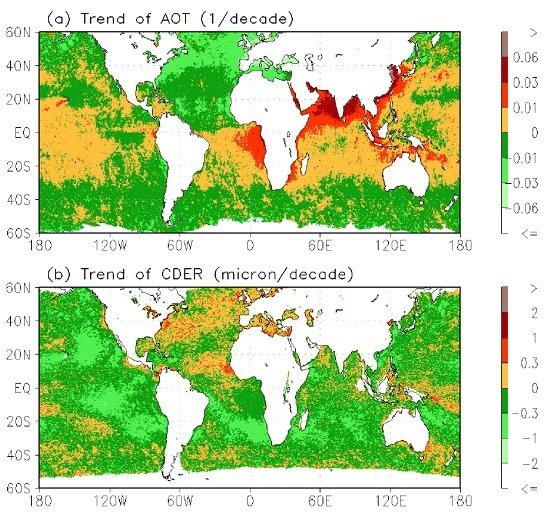Climatology Analysis of Aerosol Effect on Marine Water Cloud from Long-Term Satellite Climate Data Records
Abstract
:1. Introduction
2. Satellite Data
3. Climatology Analysis and Results
3.1. Analysis Methodology
3.2. Results
3.2.1. Long-Term Averages
3.2.2. Seasonal Features
3.2.3. Regional Survey
3.2.4. Trend
4. Summary and Conclusions
Acknowledgments
Author Contributions
Conflicts of Interest
Abbreviations
| AERONET | Aerosol Robotic Network |
| AIE | Aerosol Indirect Effect |
| AOT(s) | Aerosol Optical Thickness(es) |
| AVHRR | Advanced Very High Resolution Radiometer |
| CALIPSO | Cloud-Aerosol Lidar and Infrared Pathfinder Satellite Observations |
| CCN | Cloud Condensation Nuclei |
| CDER | Cloud Droplet Effective Radius |
| CDR(s) | Climate Data Record(s) |
| CIMSS | Cooperative Institute for Meteorological Satellite Studies |
| CN | Condensation Nuclei |
| COD | Cloud Optical Depth |
| CWP | Cloud Water Path |
| GAC | Global Area Coverage |
| LT | Linear Trend |
| NCEI | National Centers for Environmental Information |
| NESDIS | National Environmental Satellite, Data, and Information Service |
| NH | Northern Hemisphere |
| NOAA | National Ocean and Atmospheric Administration |
| MODIS | Moderate Resolution Imaging Spectroradiometer |
| PATMOS-x | Pathfinder Atmospheres-Extended |
| SH | Southern Hemisphere |
| STAR | Center for Satellite Applications and Research |
References
- Twomey, S. The nuclei of natural cloud formation, part II, the supersaturation in natural clouds and the variation of cloud droplet concentration. Pure Appl. Geophys. 1959, 43, 243–249. [Google Scholar] [CrossRef]
- Verheggen, B.; Cozic, J.; Weingartner, E.; Bower, K.; Mertes, S.; Connolly, P.; Gallagher, M.; Flynn, M.; Choularton, T.; Baltensperger, U. Aerosol partitioning between the interstitial and the condensed phase in mixed-phase clouds. J. Geophys. Res. Atmos. 2007, 112. [Google Scholar] [CrossRef]
- Mason, B.J. The Physics of Clouds; Clarendon Press: Oxford, UK, 2010. [Google Scholar]
- Twomey, S. Pollution and planetary albedo. Atmos. Environ. 1974, 8, 1251–1256. [Google Scholar] [CrossRef]
- Twomey, S.A.; Piepgrass, M.; Wolfe, T.L. An assessment of the impact of pollution on global cloud albedo. Tellus B 1984, 36, 356–366. [Google Scholar] [CrossRef]
- Coakley, J.A.; Bernstein, R.L.; Durkee, P.A. Effect of ship-stack effluents on cloud reflectivity. Science 1987, 237, 1020–1022. [Google Scholar] [CrossRef] [PubMed]
- Charlson, R.J.; Schwartz, S.E.; Hales, J.M.; Cess, R.D.; Coakley, J.A.; Hansen, J.E.; Hofmann, D.J. Climate forcing by anthropogenic aerosols. Science 1992, 255, 423–430. [Google Scholar] [CrossRef] [PubMed]
- Ramanathan, V.; Crutzen, P.J.; Kiehl, J.T.; Rosenfeld, D. Atmosphere—Aerosols, climate, and the hydrological cycle. Science 2001, 294, 2119–2124. [Google Scholar] [CrossRef] [PubMed]
- Breon, F.M.; Tanre, D.; Generoso, S. Aerosol effect on cloud droplet size monitored from satellite. Science 2002, 295, 834–838. [Google Scholar] [CrossRef] [PubMed]
- Stevens, B.; Feingold, G. Untangling aerosol effects on clouds and precipitation in a buffered system. Nature 2009, 461, 607–613. [Google Scholar] [CrossRef] [PubMed]
- Radke, L.F.; Coakley, J.A.; King, M.D. Direct and remote-sensing observations of the effects of ships on clouds. Science 1989, 246, 1146–1149. [Google Scholar] [CrossRef] [PubMed]
- Albrecht, B.A. Aerosols, cloud microphysics, and fractional cloudiness. Science 1989, 245, 1227–1230. [Google Scholar] [CrossRef] [PubMed]
- Kaufman, Y.J.; Fraser, R.S. The effect of smoke particles on clouds and climate forcing. Science 1997, 277, 1636–1639. [Google Scholar] [CrossRef]
- Kaufman, Y.J.; Koren, I. Smoke and pollution aerosol effect on cloud cover. Science 2006, 313, 655–658. [Google Scholar] [CrossRef] [PubMed]
- Rosenfeld, D.; Lohmann, U.; Raga, G.B.; O’Dowd, C.D.; Kulmala, M.; Fuzzi, S.; Reissell, A.; Andreae, M.O. Flood or drought: How do aerosols affect precipitation? Science 2008, 321, 1309–1313. [Google Scholar] [CrossRef] [PubMed]
- Lu, M.L.; Conant, W.C.; Jonsson, H.H.; Varutbangkul, V.; Flagan, R.C.; Seinfeld, J.H. The marine stratus/stratocumulus experiment (mase): Aerosol-cloud relationships in marine stratocumulus. J. Geophys. Res. Atmos. 2007, 112. [Google Scholar] [CrossRef]
- Stevens, B. Why are (precipitation mediated) aerosol effects on clouds so difficult to establish? Geochim. Cosmochim. Acta 2009, 73, A1274. [Google Scholar]
- Twohy, C.H.; Hudson, J.G. Measurements of cloud condensation nuclei spectra within maritime cumulus cloud droplets—Implications for mixing processes. J. Appl. Meteorol. 1995, 34, 815–833. [Google Scholar] [CrossRef]
- Leaitch, W.R.; Banic, C.M.; Isaac, G.A.; Couture, M.D.; Liu, P.S.K.; Gultepe, I.; Li, S.M.; Kleinman, L.; Daum, P.H.; MacPherson, J.I. Physical and chemical observations in marine stratus during the 1993 North Atlantic regional experiment: Factors controlling cloud droplet number concentrations. J. Geophys. Res. Atmos. 1996, 101, 29123–29135. [Google Scholar] [CrossRef]
- Brenguier, J.L.; Pawlowska, H.; Schuller, L.; Preusker, R.; Fischer, J.; Fouquart, Y. Radiative properties of boundary layer clouds: Droplet effective radius vs. number concentration. J. Atmos. Sci. 2000, 57, 803–821. [Google Scholar] [CrossRef]
- Pawlowska, H.; Brenguier, J.L. Microphysical properties of stratocumulus clouds during ACE-2. Tellus B 2000, 52, 868–887. [Google Scholar] [CrossRef]
- Brenguier, J.L.; Bakan, S. Eucrex-1994: An experimental study of the radiative properties of marine boundary-layer clouds—Preface. Atmos. Res. 2000, 55, 1–2. [Google Scholar] [CrossRef]
- Durkee, P.A.; Noone, K.J.; Bluth, R.T. The monterey area ship track experiment. J. Atmos. Sci. 2000, 57, 2523–2541. [Google Scholar] [CrossRef]
- Li, Z.Q.; Niu, F.; Fan, J.W.; Liu, Y.G.; Rosenfeld, D.; Ding, Y.N. Long-term impacts of aerosols on the vertical development of clouds and precipitation. Nat. Geosci. 2011, 4, 888–894. [Google Scholar] [CrossRef]
- Kaufman, Y.J.; Nakajima, T. Effect of amazon smoke on cloud microphysics and albedo—Analysis from satellite imagery. J. Appl. Meteorol. 1993, 32, 729–744. [Google Scholar] [CrossRef]
- Rosenfeld, D. Suppression of rain and snow by urban and industrial air pollution. Science 2000, 287, 1793–1796. [Google Scholar] [CrossRef] [PubMed]
- Feingold, G.; Remer, L.A.; Ramaprasad, J.; Kaufman, Y.J. Analysis of smoke impact on clouds in Brazilian biomass burning regions: An extension of Twomey’s approach. J. Geophys. Res. Atmos. 2001, 106, 22907–22922. [Google Scholar] [CrossRef]
- Matheson, M.A.; Coakley, J.A.; Tahnk, W.R. Aerosol and cloud property relationships for summertime stratiform clouds in the northeastern atlantic from advanced very high resolution radiometer observations. J. Geophys. Res. Atmos. 2005, 110. [Google Scholar] [CrossRef]
- Lin, J.C.; Matsui, T.; Pielke, R.A.; Kummerow, C. Effects of biomass-burning-derived aerosols on precipitation and clouds in the Amazon Basin: A satellite-based empirical study. J. Geophys. Res. Atmos. 2006, 111. [Google Scholar] [CrossRef]
- Koren, I.; Martins, J.V.; Remer, L.A.; Afargan, H. Smoke invigoration vs. inhibition of clouds over the amazon. Science 2008, 321, 946–949. [Google Scholar] [CrossRef] [PubMed]
- Han, Q.Y.; Rossow, W.B.; Lacis, A.A. Near-global survey of effective droplet radii in liquid water clouds using ISCCP data. J. Clim. 1994, 7, 465–497. [Google Scholar] [CrossRef]
- Han, Q.Y.; Rossow, W.B.; Zeng, J.; Welch, R. Three different behaviors of liquid water path of water clouds in aerosol-cloud interactions. J. Atmos. Sci. 2002, 59, 726–735. [Google Scholar] [CrossRef]
- Wetzel, M.A.; Stowe, L.L. Satellite-observed patterns in stratus microphysics, aerosol optical thickness, and shortwave radiative forcing. J. Geophys. Res. Atmos. 1999, 104, 31287–31299. [Google Scholar] [CrossRef]
- Nakajima, T.; Higurashi, A.; Kawamoto, K.; Penner, J.E. A possible correlation between satellite-derived cloud and aerosol microphysical parameters. Geophys. Res. Lett. 2001, 28, 1171–1174. [Google Scholar] [CrossRef]
- Sekiguchi, M.; Nakajima, T.; Suzuki, K.; Kawamoto, K.; Higurashi, A.; Rosenfeld, D.; Sano, I.; Mukai, S. A study of the direct and indirect effects of aerosols using global satellite data sets of aerosol and cloud parameters. J. Geophys. Res. Atmos. 2003, 108. [Google Scholar] [CrossRef]
- Kaufman, Y.J.; Koren, I.; Remer, L.A.; Rosenfeld, D.; Rudich, Y. The effect of smoke, dust, and pollution aerosol on shallow cloud development over the Atlantic Ocean. Proc. Natl. Acad. Sci. USA 2005, 102, 11207–11212. [Google Scholar] [CrossRef] [PubMed]
- Loeb, N.G.; Schuster, G.L. An observational study of the relationship between cloud, aerosol and meteorology in broken low-level cloud conditions. J. Geophys. Res. Atmos. 2008, 113. [Google Scholar] [CrossRef]
- Ghan, S.J.; Chuang, C.C.; Penner, J.E. A parameterization of cloud droplet nucleation part I: Single aerosol type. Atmos. Res. 1993, 30, 198–221. [Google Scholar] [CrossRef]
- Menon, S.; Del Genio, A.D.; Koch, D.; Tselioudis, G. GCM simulations of the aerosol indirect effect: Sensitivity to cloud parameterization and aerosol burden. J. Atmos. Sci. 2002, 59, 692–713. [Google Scholar] [CrossRef]
- Menon, S.; Brenguier, J.L.; Boucher, O.; Davison, P.; Del Genio, A.D.; Feichter, J.; Ghan, S.; Guibert, S.; Liu, X.H.; Lohmann, U.; et al. Evaluating aerosol/cloud/radiation process parameterizations with single-column models and second aerosol characterization experiment (ACE-2) cloudy column observations. J. Geophys. Res. Atmos. 2003, 108. [Google Scholar] [CrossRef]
- Brenguier, J.L.; Pawlowska, H.; Schuller, L. Cloud microphysical and radiative properties for parameterization and satellite monitoring of the indirect effect of aerosol on climate. J. Geophys. Res. Atmos. 2003, 108. [Google Scholar] [CrossRef]
- Pawlowska, H.; Brenguier, J.L. An observational study of drizzle formation in stratocumulus clouds for general circulation model (GCM) parameterizations. J. Geophys. Res. Atmos. 2003, 108. [Google Scholar] [CrossRef]
- Morrison, H.; Curry, J.A.; Khvorostyanov, V.I. A new double-moment microphysics parameterization for application in cloud and climate models. Part I: Description. J. Atmos. Sci. 2005, 62, 1665–1677. [Google Scholar] [CrossRef]
- Morrison, H.; Curry, J.A.; Shupe, M.D.; Zuidema, P. A new double-moment microphysics parameterization for application in cloud and climate models. Part II: Single-column modeling of arctic clouds. J. Atmos. Sci. 2005, 62, 1678–1693. [Google Scholar] [CrossRef]
- Rotstayn, L.D.; Liu, Y.G. Sensitivity of the first indirect aerosol effect to an increase of cloud droplet spectral dispersion with droplet number concentration. J. Clim. 2003, 16, 3476–3481. [Google Scholar] [CrossRef]
- Rotstayn, L.D.; Liu, Y.G. Cloud droplet spectral dispersion and the indirect aerosol effect: Comparison of two treatments in a GCM. Geophys. Res. Lett. 2009, 36. [Google Scholar] [CrossRef]
- Rotstayn, L.D. Indirect forcing by anthropogenic aerosols: A global climate model calculation of the effective-radius and cloud-lifetime effects. J. Geophys. Res. Atmos. 1999, 104, 9369–9380. [Google Scholar] [CrossRef]
- Rotstayn, L.D.; Liu, Y.G. A smaller global estimate of the second indirect aerosol effect. Geophys. Res. Lett. 2005, 32. [Google Scholar] [CrossRef]
- Lohmann, U.; Feichter, J.; Penner, J.; Leaitch, R. Indirect effect of sulfate and carbonaceous aerosols: A mechanistic treatment. J. Geophys. Res. Atmos. 2000, 105, 12193–12206. [Google Scholar] [CrossRef]
- Lohmann, U.; Koren, I.; Kaufman, Y.J. Disentangling the role of microphysical and dynamical effects in determining cloud properties over the Atlantic. Geophys. Res. Lett. 2006, 33. [Google Scholar] [CrossRef]
- Lohmann, U.; Feichter, J. Global indirect aerosol effects: A review. Atmos. Chem. Phys. 2005, 5, 715–737. [Google Scholar] [CrossRef]
- Suzuki, K.; Nakajima, T.; Numaguti, A.; Takemura, T.; Kawamoto, K.; Higurashi, A. A study of the aerosol effect on a cloud field with simultaneous use of GCM modeling and satellite observation. J. Atmos. Sci. 2004, 61, 179–194. [Google Scholar] [CrossRef]
- Cheng, Y.J.; Lohmann, U.; Zhang, J.H. Contribution of changes in sea surface temperature and aerosol loading to the decreasing precipitation trend in southern China. J. Clim. 2005, 18, 1381–1390. [Google Scholar] [CrossRef]
- Chou, C.; Neelin, J.D.; Lohmann, U.; Feichter, J. Local and remote impacts of aerosol climate forcing on tropical precipitation. J. Clim. 2005, 18, 4621–4636. [Google Scholar] [CrossRef]
- Morrison, H.; Pinto, J.O. Mesoscale modeling of springtime arctic mixed-phase stratiform clouds using a new two-moment bulk microphysics scheme. J. Atmos. Sci. 2005, 62, 3683–3704. [Google Scholar] [CrossRef]
- Qian, Y.; Gong, D.Y.; Fan, J.W.; Leung, L.R.; Bennartz, R.; Chen, D.L.; Wang, W.G. Heavy pollution suppresses light rain in China: Observations and modeling. J. Geophys. Res. Atmos. 2009, 114. [Google Scholar] [CrossRef]
- Bennartz, R.; Fan, J.W.; Rausch, J.; Leung, L.R.; Heidinger, A.K. Pollution from china increases cloud droplet number, suppresses rain over the east China sea. Geophys. Res. Lett. 2011, 38. [Google Scholar] [CrossRef]
- Heidinger, A.K.; Cao, C.Y.; Sullivan, J.T. Using moderate resolution imaging spectrometer (MODIS) to calibrate advanced very high resolution radiometer reflectance channels. J. Geophys. Res. Atmos. 2002, 107. [Google Scholar] [CrossRef]
- Cao, C.; Weinreb, M.; Xu, H. Predicting simultaneous nadir overpasses among polar-orbiting meteorological satellites for the intersatellite calibration of radiometers. J. Atmos. Ocean. Technol. 2004, 21, 537–542. [Google Scholar] [CrossRef]
- Heidinger, A.K.; Straka, W.C.; Molling, C.C.; Sullivan, J.T.; Wu, X.Q. Deriving an inter-sensor consistent calibration for the AVHRR solar reflectance data record. Int. J. Remote Sens. 2010, 31, 6493–6517. [Google Scholar] [CrossRef]
- Heidinger, A.K.; Foster, M.J.; Walther, A.; Zhao, X.P. The pathfinder atmospheres-extended AVHRR climate dataset. Bull. Am. Meteorol. Soc. 2014, 95. [Google Scholar] [CrossRef]
- Walther, A.; Heidinger, A.K. Implementation of the daytime cloud optical and microphysical properties algorithm (DCOMP) in PATMOS-x. J. Appl. Meteorol. Clim. 2012, 51, 1371–1390. [Google Scholar] [CrossRef]
- Pavolonis, M.J.; Heidinger, A.K.; Uttal, T. Daytime global cloud typing from AVHRR and VIIRS: Algorithm description, validation, and comparisons. J. Appl. Meteorol. 2005, 44, 804–826. [Google Scholar] [CrossRef]
- Zhao, X.-P.; Dubovik, O.; Smirnov, A.; Holben, B.N.; Sapper, J.; Pietras, C.; Voss, K.J.; Frouin, R. Regional evaluation of an advanced very high resolution radiometer (AVHRR) two-channel aerosol retrieval algorithm. J. Geophys. Res. 2004, 109, D02204. [Google Scholar] [CrossRef]
- Zhao, X.-P.; Laszlo, I.; Holben, B.N.; Pietras, C.; Voss, K.J. Validation of two-channel VIRS retrievals of aerosol optical thickness over ocean and quantitative evaluation of the impact from potential subpixel cloud contamination and surface wind effect. J. Geophys. Res. Atmos. 2003, 108. [Google Scholar] [CrossRef]
- Zhao, X.-P.; Laszlo, I.; Minnis, P.; Remer, L. Comparison and analysis of two aerosol retrievals over the ocean in the terra/clouds and the earth’s radiant energy system—Moderate resolution imaging spectroradiometer single scanner footprint data: 1. Global evaluation. J. Geophys. Res. Atmos. 2005, 110. [Google Scholar] [CrossRef]
- Zhao, X.-P.; Laszlo, I.; Guo, W.; Heidinger, A.; Cao, C.; Jelenak, A.; Tarpley, D.; Sullivan, J. Study of long-term trend in aerosol optical thickness observed from operational AVHRR satellite instrument. J. Geophys. Res. 2008, 113, D07201. [Google Scholar] [CrossRef]
- Zhao, X.-P.; Heidinger, A.K.; Knapp, K.R. Long-term trends of zonally averaged aerosol optical thickness observed from operational satellite AVHRR instrument. Meteorol. Appl. 2011, 18, 440–445. [Google Scholar] [CrossRef]
- Zhao, X.P. Satellite observed aerosol optical thickness and trend around megacities in the coastal zone. Adv. Meteorol. 2015, 2015, 170672-7. [Google Scholar] [CrossRef]
- Heidinger, A.K.; Evan, A.T.; Foster, M.J. A naive Bayesian cloud-detection scheme derived from Calipso and applied withing PATMOS-x. J. Appl. Meteorol. Clim. 2012. [Google Scholar] [CrossRef]
- Stowe, L.L.; Ignatov, A.M.; Singh, R.R. Development, validation, and potential enhancements to the second-generation operational aerosol product at the national environmental satellite, data, and information service of the national oceanic and atmospheric administration. J. Geophys. Res. Atmos. 1997, 102, 16923–16934. [Google Scholar] [CrossRef]
- Ignatov, A.; Stowe, L. Aerosol retrievals from individual AVHRR channels. Part I: Retrieval algorithm and transition from dave to 6 s radiative transfer model. J. Atmos. Sci. 2002, 59, 313–334. [Google Scholar] [CrossRef]
- Shao, H.F.; Liu, G.S. Why is the satellite observed aerosol’s indirect effect so variable? Geophys. Res. Lett. 2005, 32. [Google Scholar] [CrossRef]
- Stephens, G.L. Radiation profiles in extended water clouds. 1. Theory. J. Atmos. Sci. 1978, 35, 2111–2122. [Google Scholar] [CrossRef]
- Bennartz, R. Global assessment of marine boundary layer cloud droplet number concentration from satellite. J. Geophys. Res. Atmos. 2007, 112, D02201. [Google Scholar]
- Dong, X.Q.; Schwantes, A.C.; Xi, B.K.; Wu, P. Investigation of the marine boundary layer cloud and CCN properties under coupled and decoupled conditions over the azores. J. Geophys. Res. Atmos. 2015, 120, 6179–6191. [Google Scholar] [CrossRef]
- Logan, T.; Xi, B.K.; Dong, X.Q. Aerosol properties and their influences on marine boundary layer cloud condensation nuclei at the arm mobile facility over the Azores. J. Geophys. Res. Atmos. 2014, 119, 4859–4872. [Google Scholar] [CrossRef]
- Pruppacher, H.R.; Klett, J.D. Microphysics of Clouds and Precipitation; Kluwer Academy: Dordrecht, the Netherlands, 1997. [Google Scholar]
- Johnson, D.W.; Osborne, S.; Wood, R.; Suhre, K.; Johnson, R.; Businger, S.; Quinn, P.K.; Wiedensohler, A.; Durkee, P.A.; Russell, L.M.; et al. An overview of the Lagrangian experiments undertaken during the North Atlantic regional aerosol characterisation experiment (ACE-2). Tellus B 2000, 52, 290–320. [Google Scholar] [CrossRef]
- Brenguier, J.L.; Chuang, P.Y.; Fouquart, Y.; Johnson, D.W.; Parol, F.; Pawlowska, H.; Pelon, J.; Schuller, L.; Schroder, F.; Snider, J. An overview of the ACE-2 cloudycolumn closure experiment. Tellus B 2000, 52, 815–827. [Google Scholar] [CrossRef] [Green Version]
- Raes, F.; Bates, T.; McGovern, F.; Van Liedekerke, M. The 2nd aerosol characterization experiment (ACE-2): General overview and main results. Tellus B 2000, 52, 111–125. [Google Scholar] [CrossRef]
- Zhao, T.X.P.; Chan, P.K.; Heidinger, A.K. A global survey of the effect of cloud contamination on the aerosol optical thickness and its long-term trend derived from operational AVHRR satellite observations. J. Geophys. Res. Atmos. 2013, 118, 2849–2857. [Google Scholar] [CrossRef]
- Tiao, G.C.; Reinsel, G.C.; Xu, D.M.; Pedrick, J.H.; Zhu, X.D.; Miller, A.J.; Deluisi, J.J.; Mateer, C.L.; Wuebbles, D.J. Effects of autocorrelation and temporal sampling schemes on estimates of trend and spatial correlation. J. Geophys. Res. Atmos. 1990, 95, 20507–20517. [Google Scholar] [CrossRef]
- Wilks, D.S. Statistical Methods in the Atmosphere Sciences; Academic Press: San Diego, CA, USA, 1995. [Google Scholar]
- Weatherhead, E.C.; Reinsel, G.C.; Tiao, G.C.; Meng, X.L.; Choi, D.S.; Cheang, W.K.; Keller, T.; DeLuisi, J.; Wuebbles, D.J.; Kerr, J.B.; et al. Factors affecting the detection of trends: Statistical considerations and applications to environmental data. J. Geophys. Res. Atmos. 1998, 103, 17149–17161. [Google Scholar] [CrossRef]
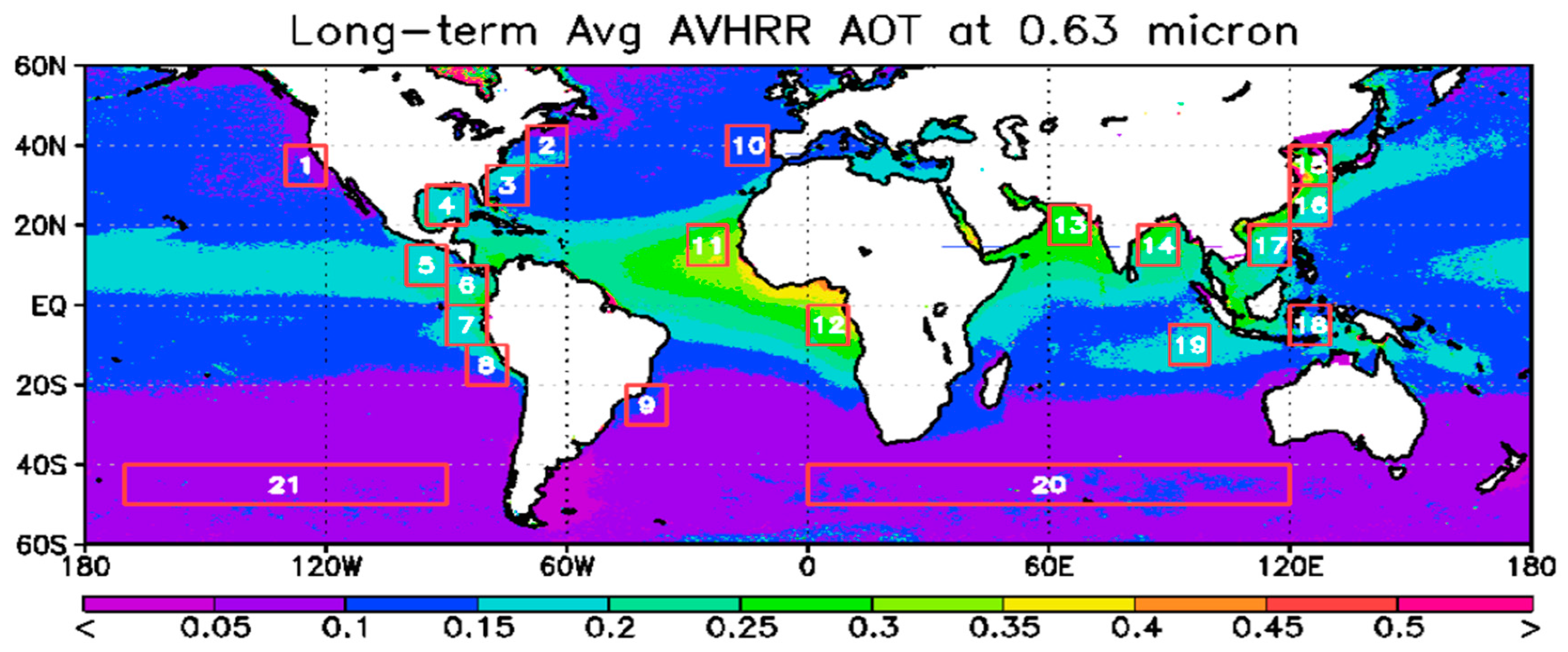
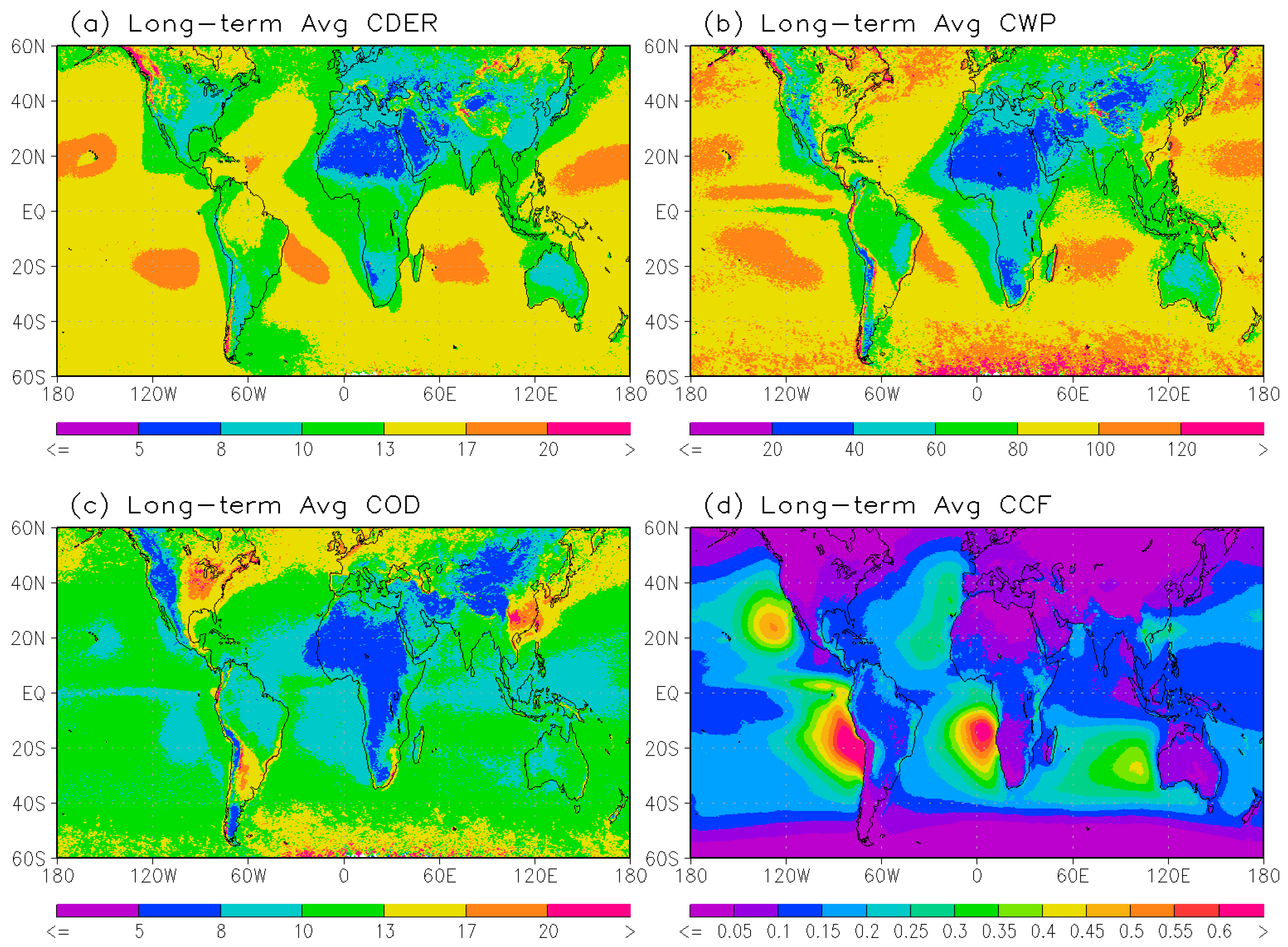
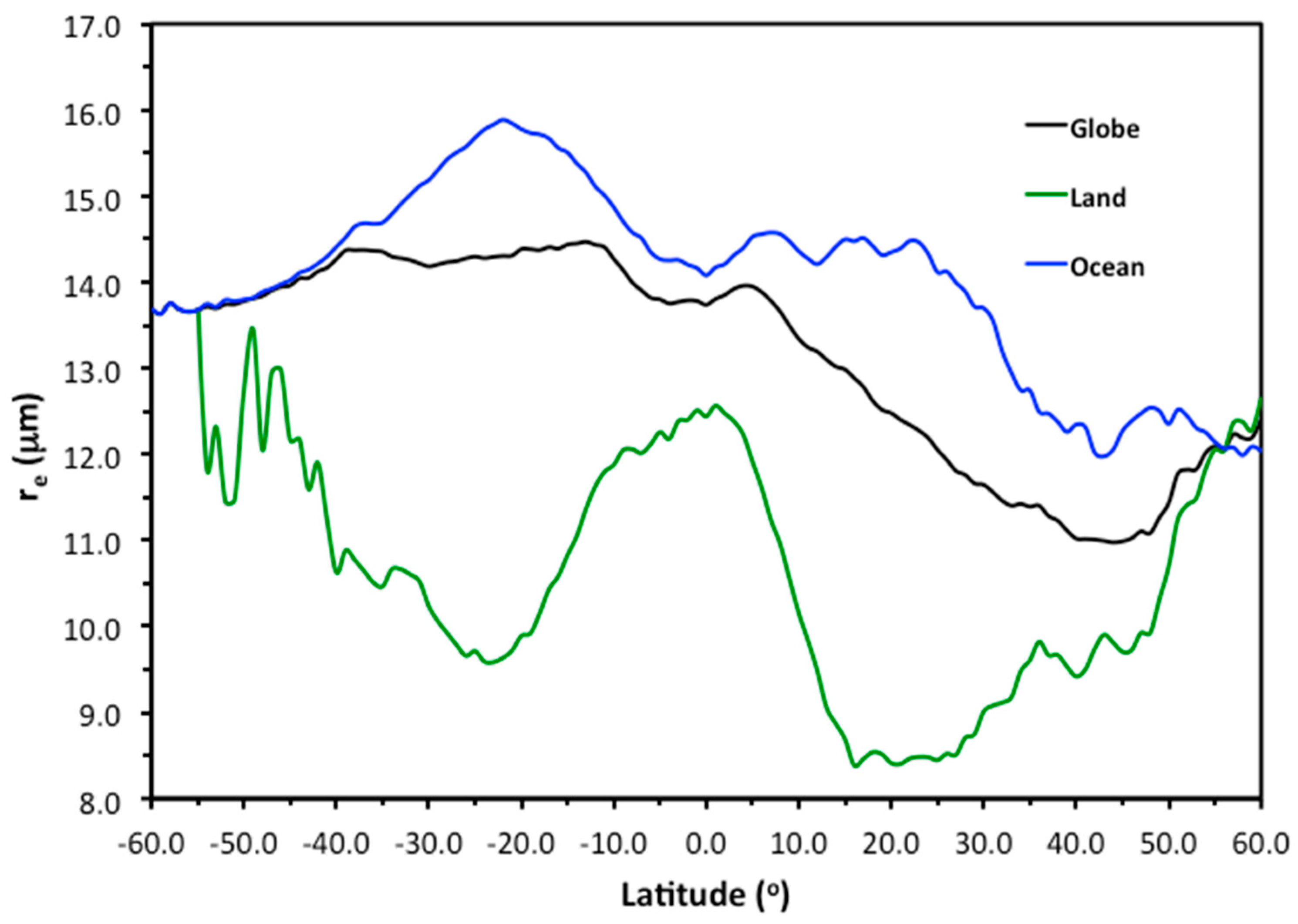
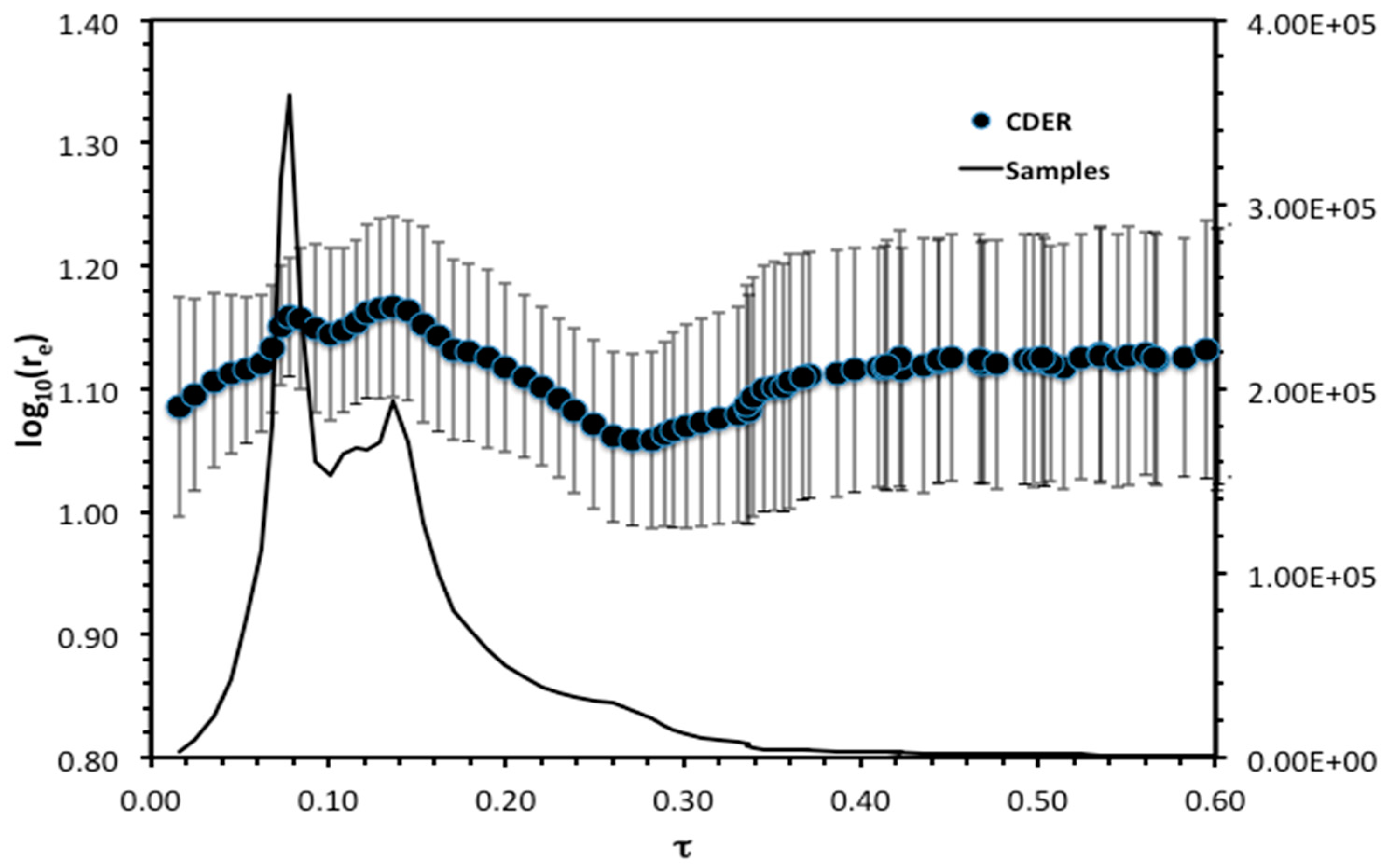
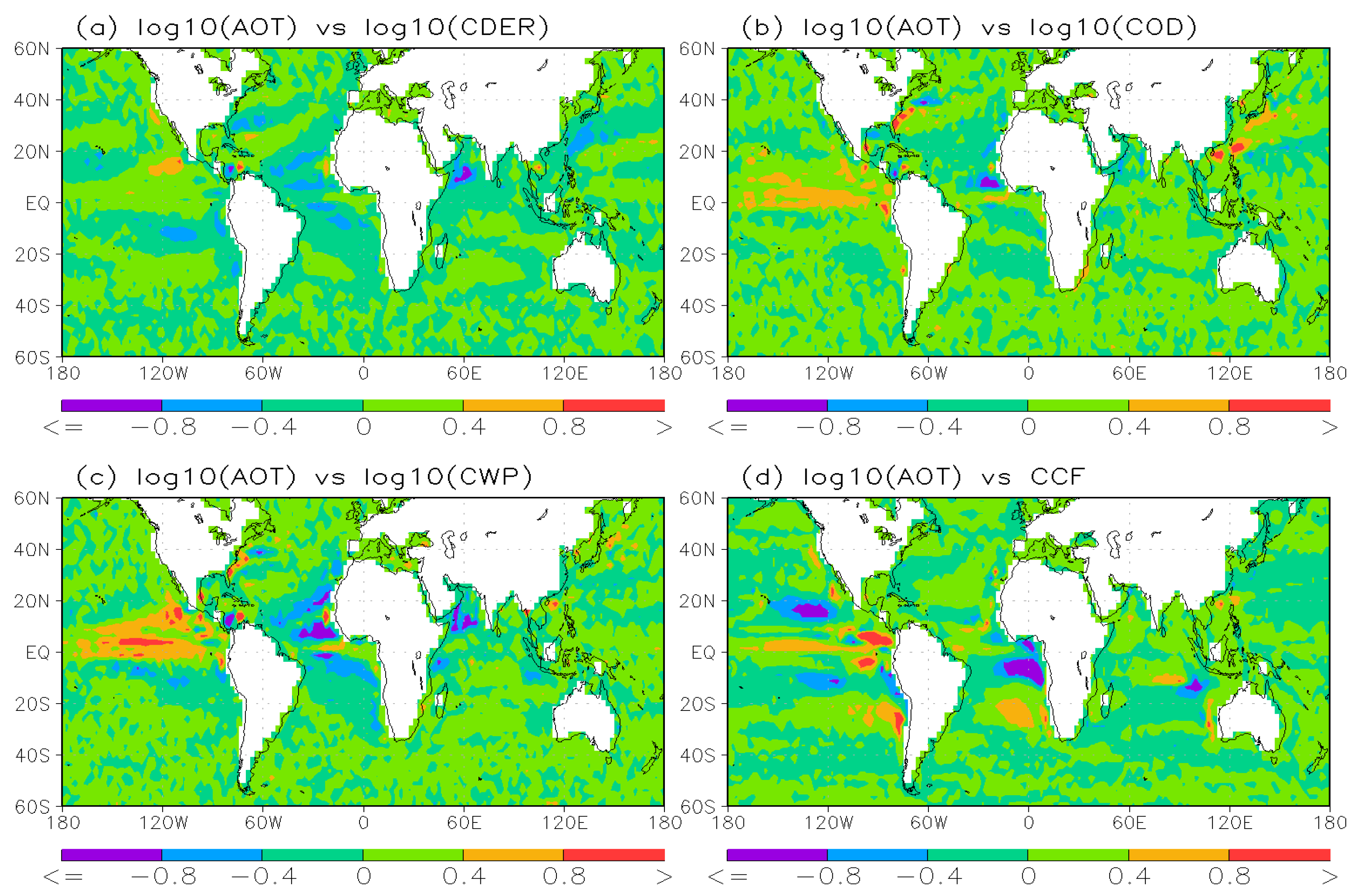

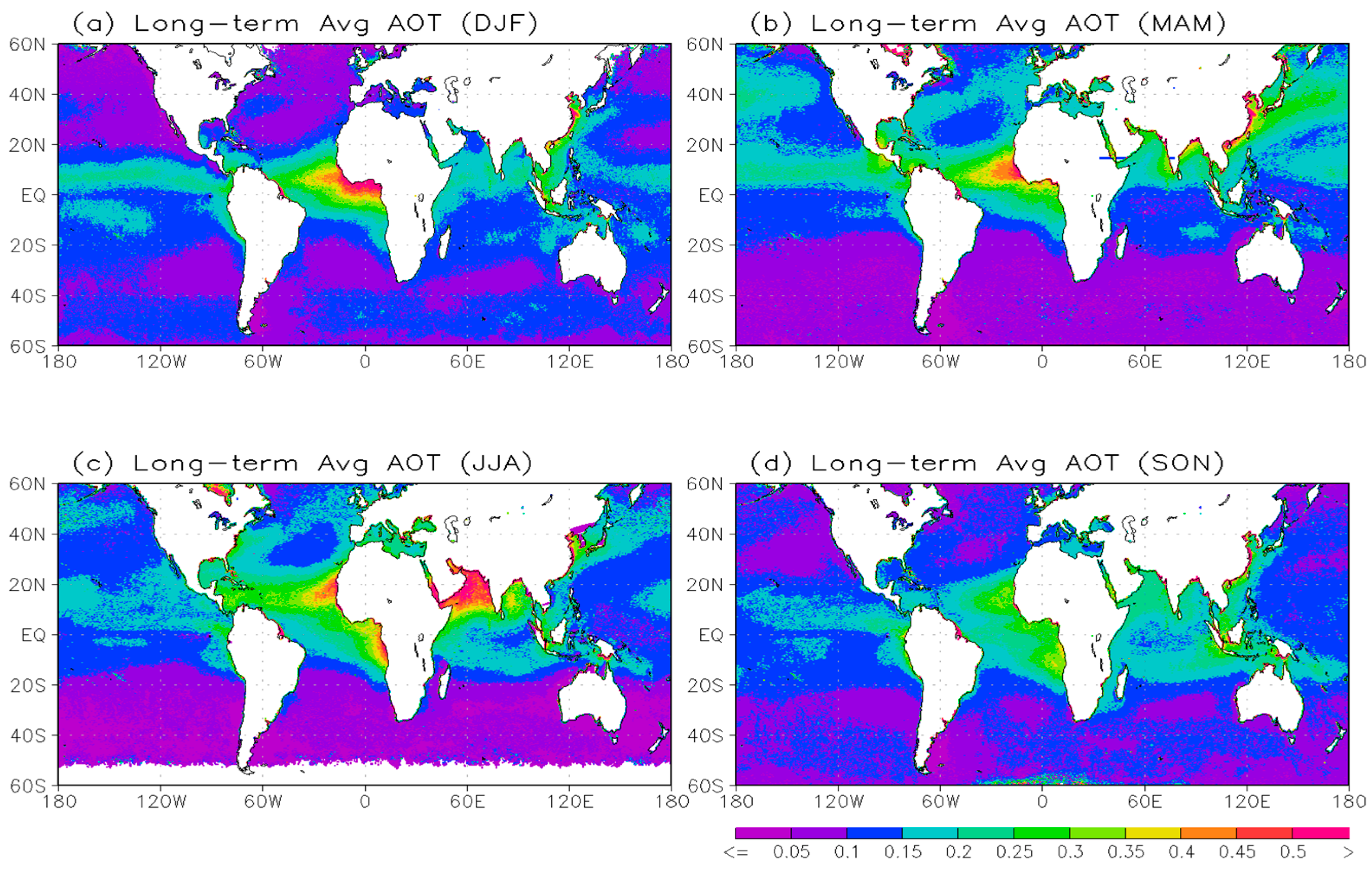
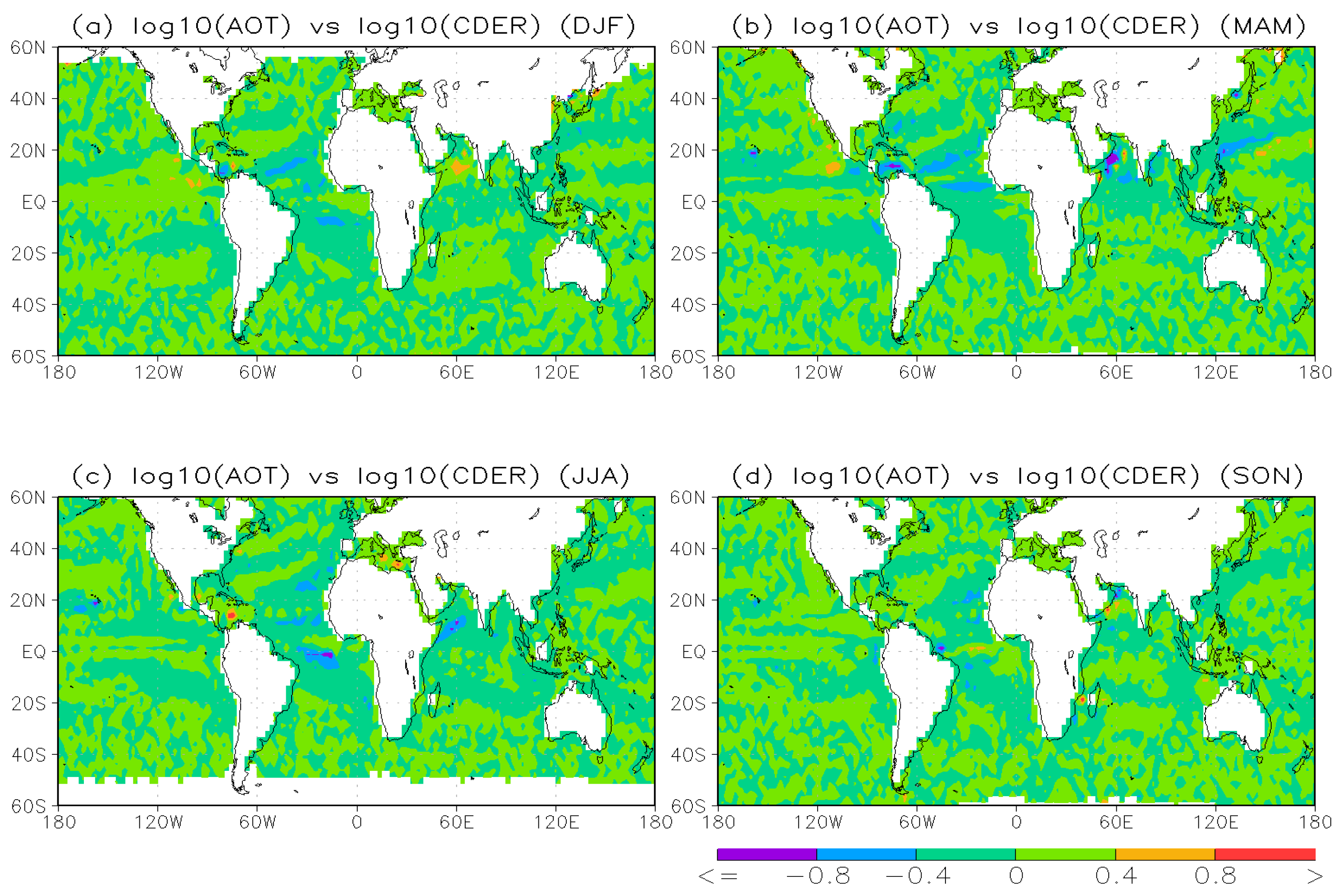
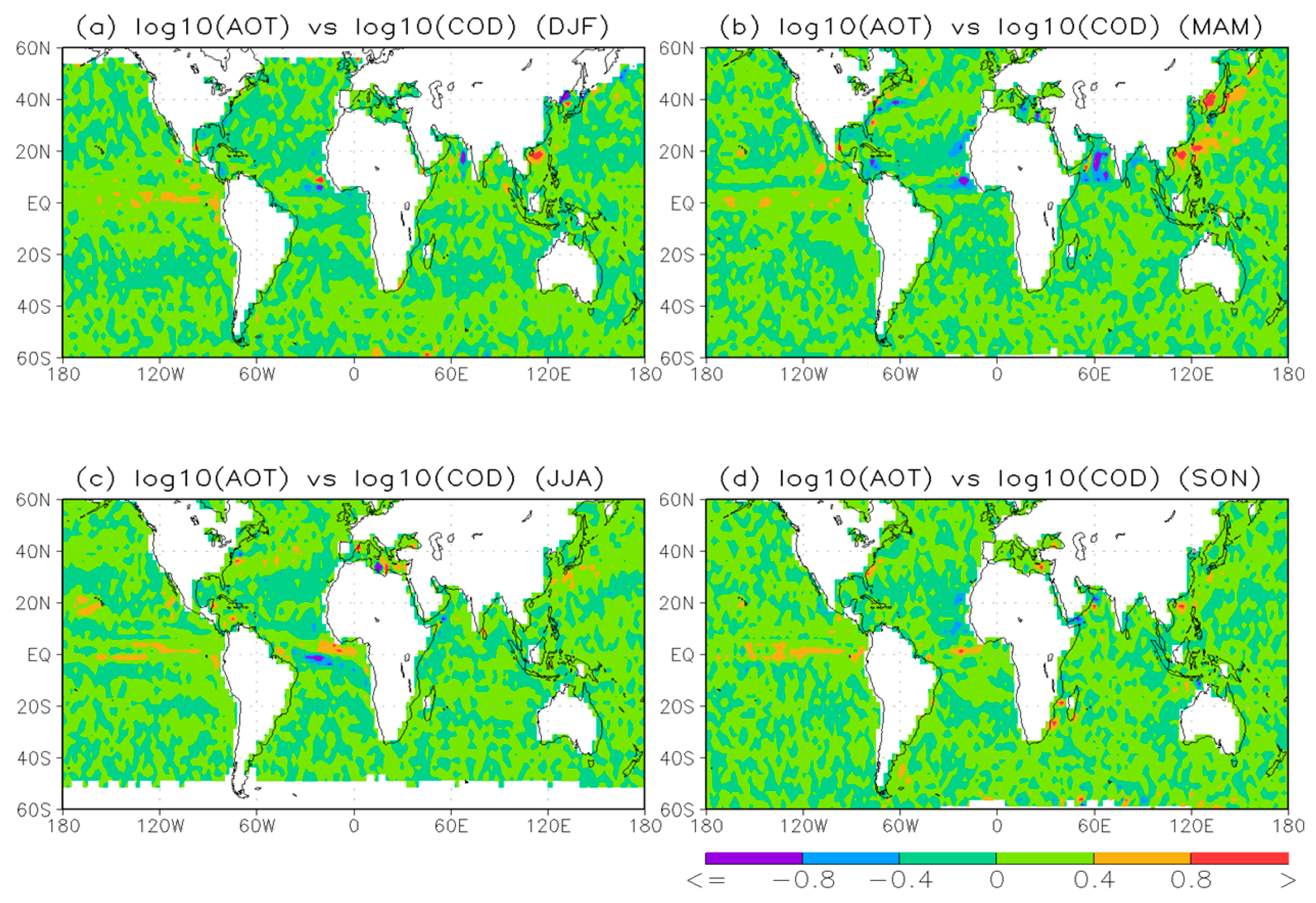
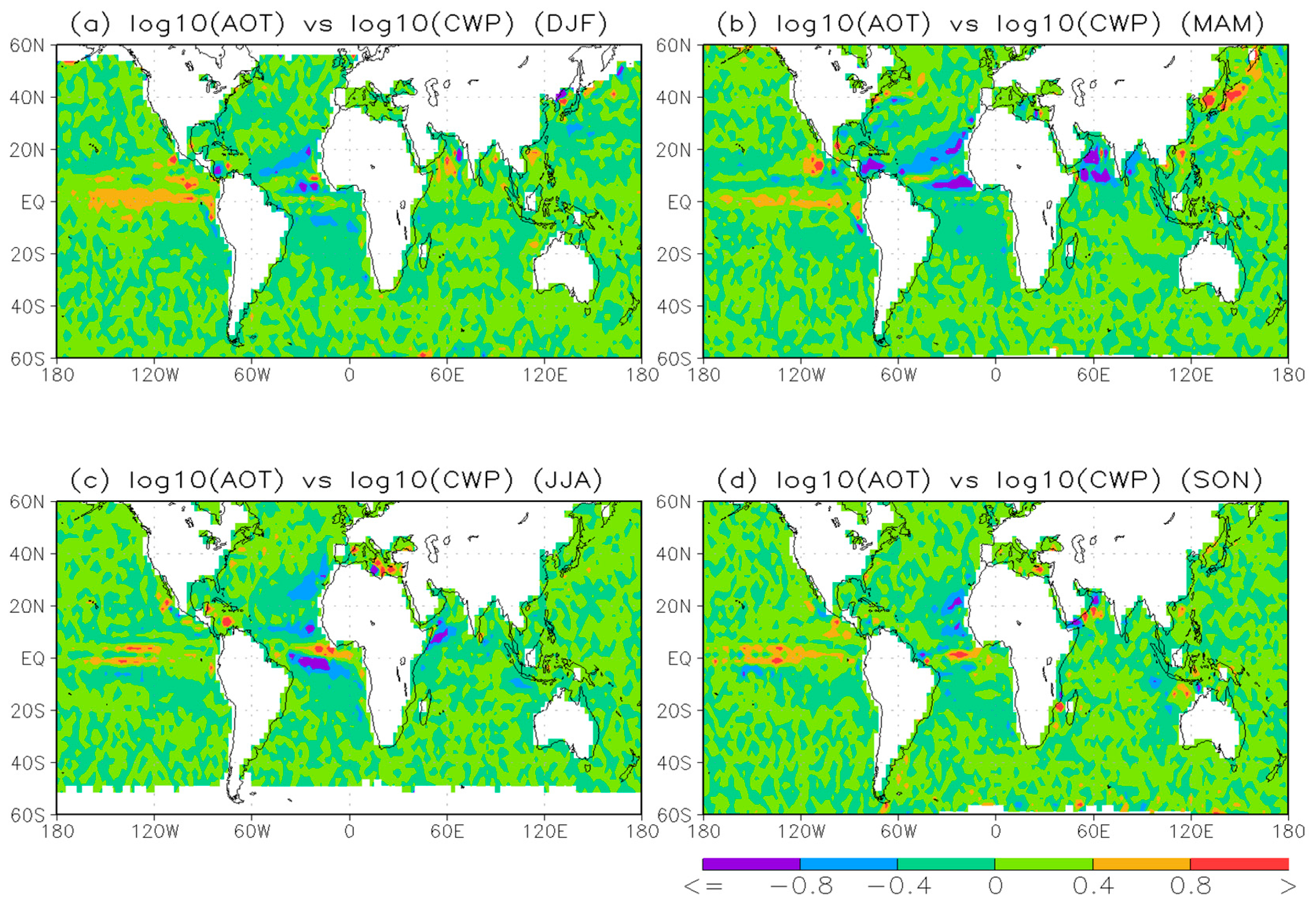
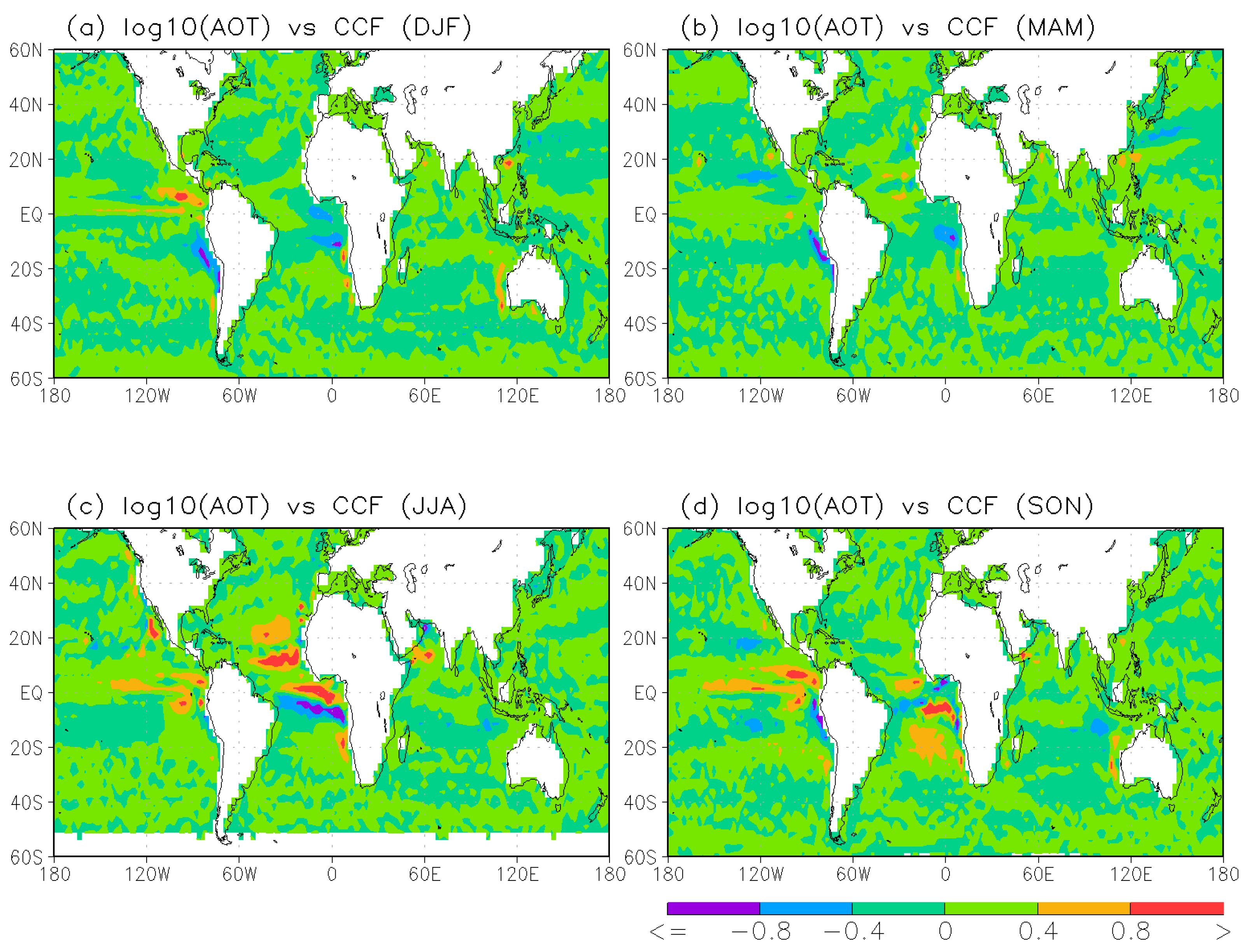
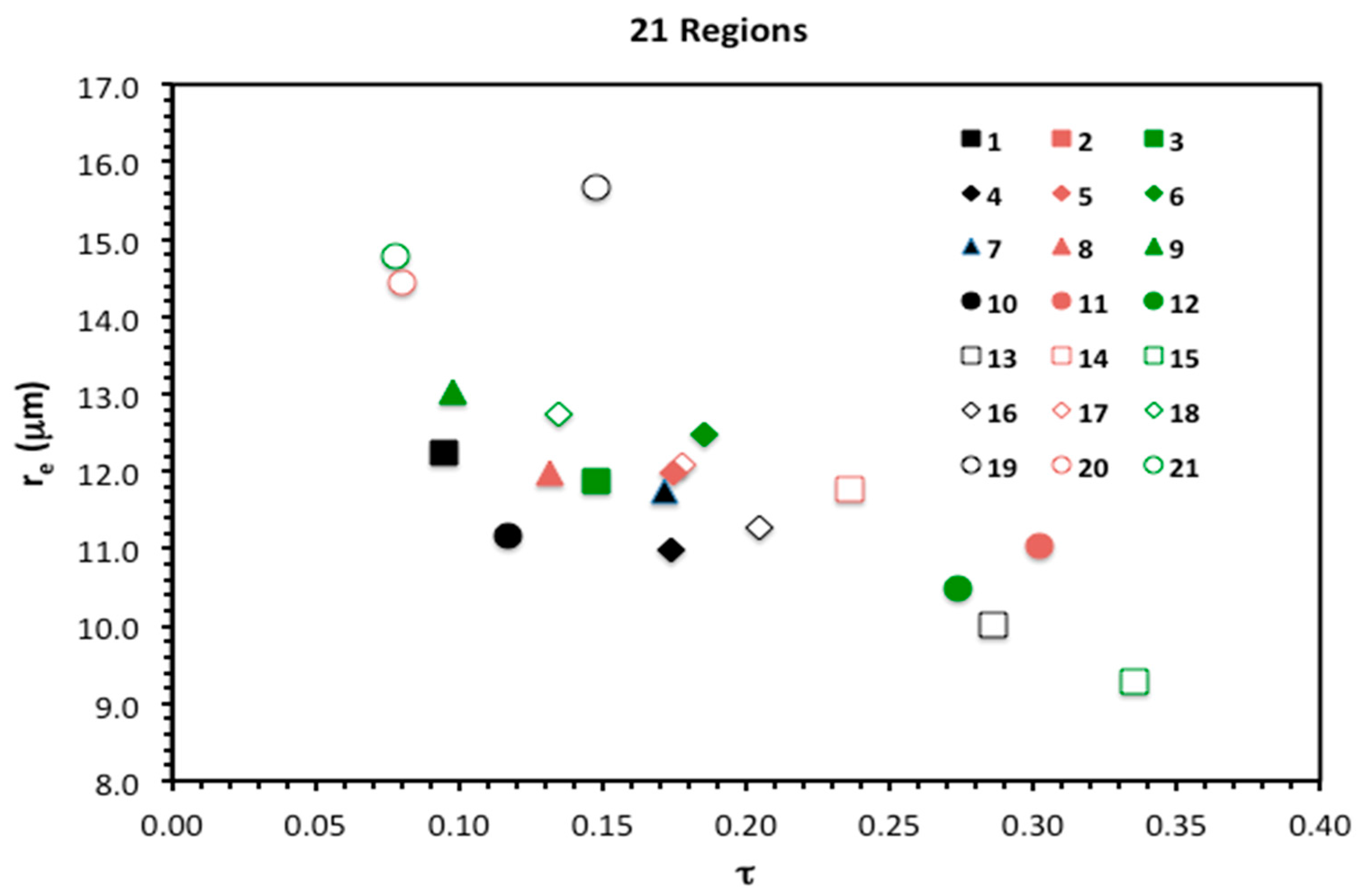
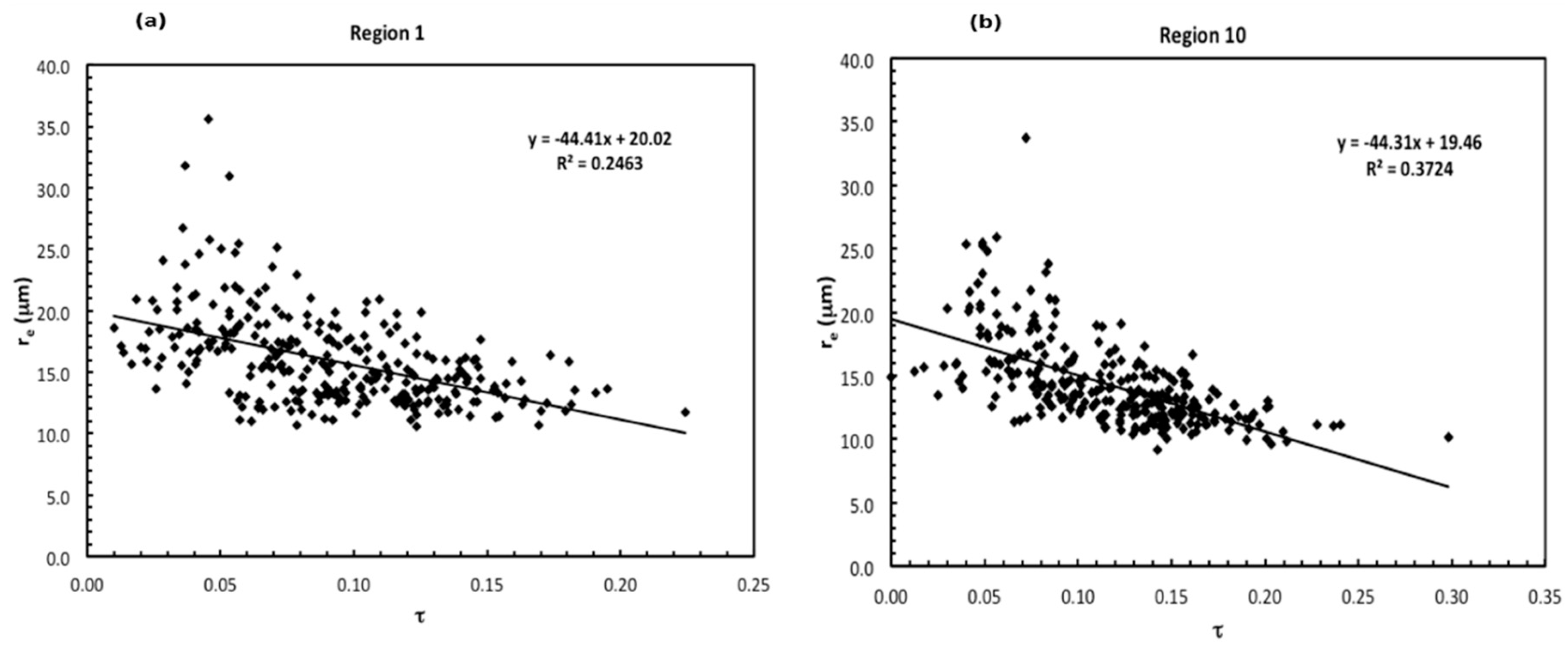

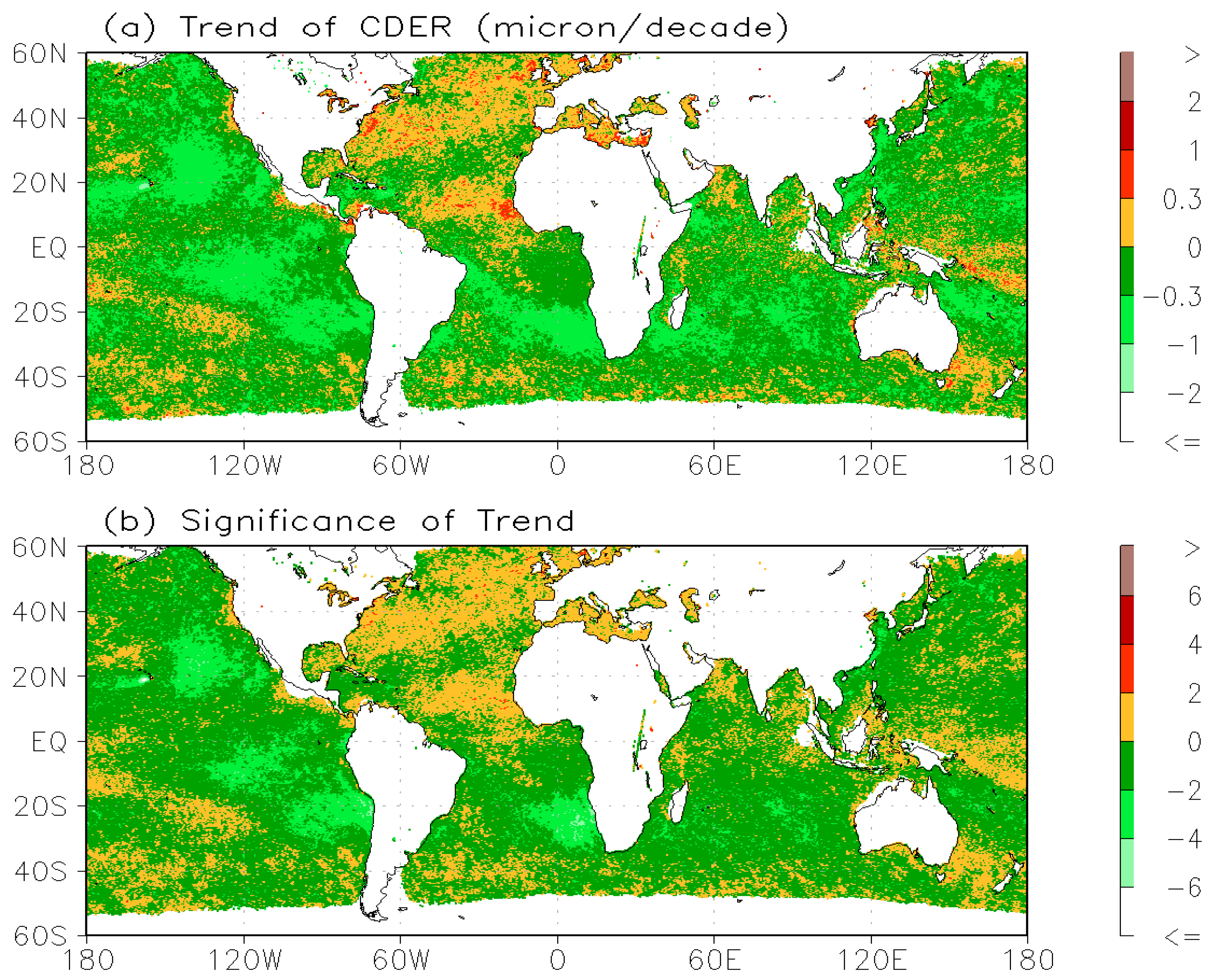
| Region | Longitude Bounds | Latitude Bounds | Region | Longitude Bounds | Latitude Bounds |
|---|---|---|---|---|---|
| 1 | −130.0°, −120.0° | 30.0°, 40.0° | 12 | 0.0°, 10.0° | −10.0°, 0.0° |
| 2 | −70.0°, −60.0° | 35.0°, 45.0° | 13 | 60.0°, 70.0° | 15.0°, 25.0° |
| 3 | −80.0°, −70.0° | 20.0°, 30.0° | 14 | 82.0°, 92.0° | 10.0°, 20.0° |
| 4 | −95.0°, −85.0° | 20.0°, 30.0° | 15 | 120.0°, 130.0° | 30.0°, 40.0° |
| 5 | −100.0°, −90.0° | 5.0°, 15.0° | 16 | 120.0°, 130.0° | 20.0°, 30.0° |
| 6 | −90.0°, −80.0° | 0.0°, 10.0° | 17 | 110.0°, 120.0° | 10.0°, 20.0° |
| 7 | −90.0°, −80.0° | −10.0°, 0.0° | 18 | 120.0°, 130.0° | −10.0°, 0.0° |
| 8 | −85.0°, −75.0° | −20.0°, −10.0° | 19 | 90.0°, 100.0° | −15.0°, −5.0° |
| 9 | −45.0°, −35.0° | −30.0°, −20.0° | 20 | 0.0°, 120.0° | −50.0°, −40.0° |
| 10 | −20.0°, −10.0° | 35.0°, 45.0° | 21 | −170.0°, −90.0° | −50.0°, −40.0° |
| 11 | −30.0°, −20.0° | 10.0°, 20.0° | - | - | - |
| Region | Linear Slope | Correlation Coefficient | Typical Aerosol Types |
|---|---|---|---|
| 1 | −44.43 | 0.50 | Pollution |
| 10 | −44.31 | 0.61 | Pollution |
| 11 | −14.21 | 0.34 | Dust |
| 13 | −18.38 | 0.57 | Dust and Pollution |
| 14 | −5.31 | 0.11 | Pollution |
| 16 | −9.05 | 0.23 | Pollution |
© 2016 by the authors; licensee MDPI, Basel, Switzerland. This article is an open access article distributed under the terms and conditions of the Creative Commons by Attribution (CC-BY) license (http://creativecommons.org/licenses/by/4.0/).
Share and Cite
Zhao, X.; Heidinger, A.K.; Walther, A. Climatology Analysis of Aerosol Effect on Marine Water Cloud from Long-Term Satellite Climate Data Records. Remote Sens. 2016, 8, 300. https://doi.org/10.3390/rs8040300
Zhao X, Heidinger AK, Walther A. Climatology Analysis of Aerosol Effect on Marine Water Cloud from Long-Term Satellite Climate Data Records. Remote Sensing. 2016; 8(4):300. https://doi.org/10.3390/rs8040300
Chicago/Turabian StyleZhao, Xuepeng, Andrew K. Heidinger, and Andi Walther. 2016. "Climatology Analysis of Aerosol Effect on Marine Water Cloud from Long-Term Satellite Climate Data Records" Remote Sensing 8, no. 4: 300. https://doi.org/10.3390/rs8040300
APA StyleZhao, X., Heidinger, A. K., & Walther, A. (2016). Climatology Analysis of Aerosol Effect on Marine Water Cloud from Long-Term Satellite Climate Data Records. Remote Sensing, 8(4), 300. https://doi.org/10.3390/rs8040300





